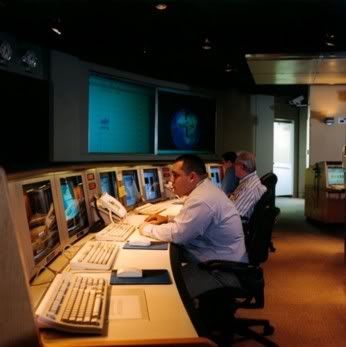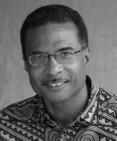Pathways to Africa's New Information Age

The regional operating center of WorldSpace, the satellite radio company founded by African visionary entrepreneur Noah Samara. WorldSpace was the progenitor of XM satellite radio, and has two geostationary satellites broadcasting to all of Africa, the Middle East, Asia and most of Western Europe.
Pathways to Africa's New Information Age
Among the pantheon of digital media revolutionizing pop culture and entertainment – the Internet, iPods and iPhones, Blackberries and PDAs, laptops and game consoles, TIVOs and DVRs – Americans are just beginning to warm up to the notion of satellite radio.
Multi-million dollar contracts, massive PR campaigns and bidding wars between satellite radio giants XM and Sirius, drawing in the likes of Howard Stern, Bob Dylan and Oprah Winfrey, are driving much of this growing interest. In high-stakes bids for the satellite radio market, both XM and Sirius have moved beyond recruiting high profile personalities and into establishing powerful alliances with automobile manufactures. The result: virtually all new cars come equipped with satellite radios as a standard feature.
In 1990 – years before Americans had even heard about satellite radio – an African engineer was on his way to becoming a major force in developing the technology and making the concept commercially viable. Today, Noah Samara remains relatively unknown. The Ethiopian of Sudanese heritage sought to establish satellite radio as an economic and technological force initiating in Africa and spreading to Asia, Europe and the developed world.
“In the mid-1980s, I read something that changed my life,” Samara said at a commencement speech at his alma mater, Stroudsberg University of Pennsylvania. “It was an article in the Washington Post about AIDS in Africa and how it was spreading because millions of people had no information or the wrong information. It became clear to me that people weren’t simply dying of disease; they were dying of ignorance. Something had to be done.”
His idea was to launch a satellite over Africa that would broadcast digital radio to inexpensive portable receivers. He quit his job.
At an international convention in 1992, Samara convinced 127 developing countries to grant him satellite bandwidth on the L-band, outmaneuvering competing proposals put forward by the Canadian and Austrian governments. He secured $1.1 billion in financial backing from powerful Saudi interests, and won approval from the Federal Communications Commission for the first U.S. satellite radio license. Samara’s brainchild, WorldSpace – the world’s first satellite radio broadcaster – launched its AfriStar satellite from French Guiana in 1998. The launch of the AsiaStar satellite followed in 2000. WorldSpace currently broadcasts satellite radio to over 130 countries including India and China, all of Africa and the Middle East and most of Western Europe – an area that includes five billion people and more than 300 million automobiles.
“We needed around $1.5 billion to make it happen,” said Samara, who was a successful lawyer with the International Telecommunications Union in 1990 when he experienced his epiphany and literally sketched out his ideas on a napkin in a restaurant.
Samara and WorldSpace were prime movers in the creation of XM – the first satellite radio broadcaster in the United States. They developed the proprietary microchip technology used in XM receivers and financed a 20 percent stake in the initial venture. Eventually WorldSpace sold its stake in XM, and the latter concentrated on the North American market while WorldSpace focused on leveraging its technology in Europe, Africa and Asia. Four percent of WorldSpace’s satellite bandwidth is dedicated to meeting the special humanitarian needs of the developing world, such as long distance education.
Unknown Genius
Samara’s story and his relative anonymity speaks volumes about mass media perceptions of Africa and how little is known of the Motherland’s potential in this new age of globalization. Much like Koos Bekker, the South African wunderkind who helped create the encryption technology that is used for most satellite subscription services throughout the world, the achievements of Samara and others of his ilk seem perpetually obscured by tragic stories about HIV/AIDS, war, famine, terrorism and conflict in Africa.
The modern media is heavily skewed toward Europe and America and strengthening age-old stereotypes of Africa as both a backward continent and a futile place for investment or progress. Africa has wide swaths of untouched wilderness and vast rural areas with no power grids and cars, but the interface with modern forces of globalization is there nonetheless.
Very few people outside of those with specialized business and telecommunications interests are aware that the African continent is surrounded by a giant submarine network of fiber optic cable extending from Portugal to Cape Town, South Africa known as the 3rd Southern Africa Telecommunication/West Africa Submarine Cable (or SAT3/WASC). This 15,000 km cable is supplemented by another 13,800 km cable extending from Cape Town to Malaysia known as the Southern Africa Far East cable (SAFE) and by a third submarine cable reaching from Cape Town to The Sudan, called the East African Submarine Cable System (EASSy). The SAT3/WASC and EASSy cable systems were spearheaded by South Africa and funded by a consortium of 12 investors from Africa, four from America, eight from Asia and 12 from Europe, contributing more than $600 million. These fiber optic cables offer the widest bandwidth and highest speed for voice, audio, data and video transmission of any modern medium (including satellite) and provide Africa with a highly desirable, state-of-the-art telecommunications infrastructure.
In the coming years, residents of some of the world’s most geographically, economically and culturally isolated regions will gain access to a global information superhighway, “leap-frogging” the costly and environmentally intrusive infrastructure originally developed in the West. Limitless renewable energy from solar photovoltaic panels and low-cost technology (such as $100 laptops, using free, open-source software) will open a window on the world. Moreover, in light of new African regional and international forums for cooperation, such as the New Partnership for African Development (NEPAD) and the African Union, the possibilities are boundless.
Ubuntu Spirit
Like Samara, Mark Shuttleworth is an African entrepreneur who merged globalization into his own vision. Shuttleworth was a business student at the University of Cape Town in 1995 when he founded Thawte, an Internet consulting business that built a full-security e-commerce Web server available outside of the United States. Both Netscape and Internet Explorer came to see Thawte as a trusted third-party authentication certifier for public key encryption technologies.
After a rapid rise in the global market Shuttleworth sold Thawte to VeriSign for $600 million. Shuttleworth then dedicated himself to his love of space travel – training with the Russian crew of Soyuz TM34, and becoming the world’s second private “space tourist.” He also developed open-source computer software systems for use in Africa and the developing world. He created the Ubuntu project, desktop and server technology dedicated to making open-source software accessible and user-friendly.
Ubuntu is an African traditional concept that roughly translates into “humanity” or “I am who I am because of who we all are.” It essentially reflects the value of community, sharing and cooperation that is prevalent among various ethnic groups throughout the African continent. From the perspective of computer technology, open-source systems – unlike proprietary operating systems like Microsoft Windows – are developed by a community of software programmers who share free access to the source code to modify it and build their own interfacing software applications.
Shuttleworth’s Ubuntu software and hardware systems are aimed at making Linux open-source operating systems accessible to ordinary, non-technical computer users. With attractive interfaces and stylish graphic artwork that markets the values of community and sharing, the Ubuntu Web site proclaims “software should be available free of charge, that software tools should be usable by people in their local language and despite any disabilities, and that people should have the freedom to customize and alter their software in whatever way they see fit.”
Ubuntu distributes the Linux operating system free of charge and operates associated programs like Edubuntu, a platform of educational software. It also runs a variety of initiatives under the Hip2BSquare brand, which aim to make mathematics and science attractive to pupils who are beginning to choose their subjects for high school.
Many African governments recognize the value of open-source software in Africa’s development and they are making commitments to use Linux systems as well as Ubuntu products. Even Microsoft owner Bill Gates, aware of the challenge open-source and Ubuntu represent, has made overtures to subsidize low-cost versions of the Microsoft Windows operating system for African governments. The future could see Africa using different technological systems, formats and software that are distinct from Microsoft Windows’ domination of the West, and more suited to Africa’s unique cultural and economic imperatives.
In Africa, things are often not what they appear to be, and there is much to see beyond the distortions and superficial perceptions of mass media images. Unbeknownst to many in the West, there are brilliant minds in Africa creating and shaping their own versions of a bright, bold and extraordinary future.

